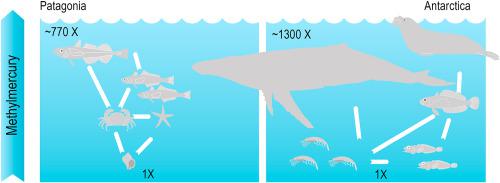Chemosphere ( IF 8.1 ) Pub Date : 2020-09-16 , DOI: 10.1016/j.chemosphere.2020.128360 Gustavo Chiang , Karen A. Kidd , Mauricio Díaz-Jaramillo , Winfred Espejo , Paulina Bahamonde , Nelson J. O’Driscoll , Kelly R. Munkittrick

|
Mercury (Hg) is a global pollutant of concern because its organic and more toxic form, methylHg (MeHg), bioaccumulates and biomagnifies through aquatic food webs to levels that affect the health of fish and fish consumers, including humans. Although much is known about trophic transfer of MeHg in aquatic food webs at temperate latitudes in the northern hemisphere, it is unclear whether its fate is similar in biota from coastal zones of the southeastern Pacific. To assess this gap, MeHg, total Hg and food web structure (using δ13C and δ15N) were measured in marine macroinvertebrates, fishes, birds, and mammals from Patagonian fjords and the Antarctic Peninsula. Trophic magnification slopes (TMS; log MeHg versus δ15N) for coastal food webs of Patagonia were high when compared with studies in the northern hemisphere, and significantly higher near freshwater inputs as compared to offshore sites (0.244 vs 0.192). Similarly, in Antarctica, the site closer to glacial inputs had a significantly higher TMS than the one in the Southern Shetland Islands (0.132 vs 0.073). Composition of the food web also had an influence, as the TMS increased when mammals and seabirds were excluded (0.132 to 0.221) at a coastal site. This study found that both the composition of the food web and the proximity to freshwater outflows are key factors influencing the TMS for MeHg in Patagonian and Antarctic food webs.
中文翻译:

巴塔哥尼亚西部和南极半岛西部沿海水生食物网中的甲基汞生物放大作用
汞(Hg)是一种全球关注的污染物,因为它的有机且毒性更大的形式甲基汞(MeHg)通过水生食物网进行生物累积和生物放大,其水平影响到鱼类和鱼类消费者(包括人类)的健康。尽管人们对北半球温带水生食物网中甲基汞的营养转移知之甚少,但尚不清楚其命运在东南太平洋沿岸生物群中是否相似。为了评估该间隙,甲基汞,总汞和食物网结构(使用δ 13 C和δ 15 N)在海洋无脊椎动物,鱼类,鸟类和哺乳动物从巴塔哥尼亚峡湾和南极半岛进行测定。营养放大斜率(TMS;登录甲基汞与δ 15与北半球的研究相比,巴塔哥尼亚沿海食物网的N)较高,与近海地点相比,近淡水输入量显着更高(0.244对0.192)。同样,在南极洲,更接近冰川输入的地点的TMS明显高于南设得兰群岛(0.132对0.073)。食物网的组成也有影响,因为在沿海地点排除哺乳动物和海鸟(0.132至0.221)时,TMS会增加。这项研究发现,食物网的组成以及与淡水流出的接近都是影响巴塔哥尼亚和南极食物网中甲基汞的TMS的关键因素。











































 京公网安备 11010802027423号
京公网安备 11010802027423号